INDEX

Map of the temple grounds 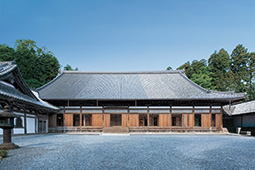
The Hondo (main temple building) 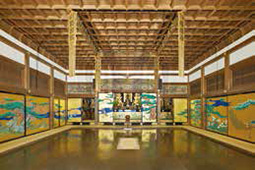
The Shitchu, also known as the Kujaku no Ma (peacock room), with screen paintings by Kano Sakyo 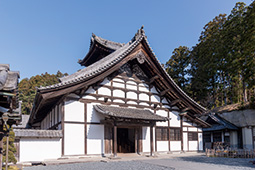
The Kuri (temple kitchen) 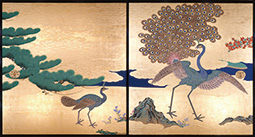
Screen painting by Kano Sakyo (reproduction)
- PREVIOUS
- NEXT
March 2021
A Zen Temple in Matsushima, One of the Three Most Scenic Spots of Japan
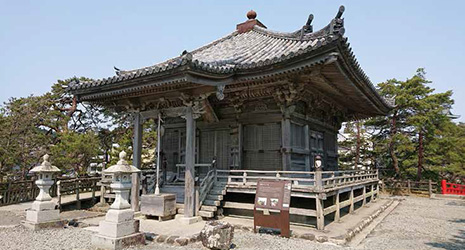
Zuiganji Temple is a national treasure situated in the town of Matsushima in Miyagi Prefecture. The temple has exemplified the beautiful combination of traditional Zen architecture and exquisite interior decoration for over 400 years.

Located in the center of Miyagi Prefecture’s coastline, Matsushima is one of the Three Most Scenic Spots of Japan, along with Miyajima in Hiroshima and Amanohashidate in Kyoto. Over 260 large and small islands dot the beautiful Matsushima Bay, which has mesmerized people for eons. Overlooking Matsushima is Zuiganji Temple, one of the largest and most highly revered Zen temples in the Tohoku region of northeast Japan.
The temple can trace its origins back to the beginning of the ninth century. Date Masamune (1567–1636), the lord of the Sendai Domain, ordered the construction of the present temple buildings, which was completed in 1609. Visitors pass through the Somon (front gate) from the coastal path, walk some 250 meters to the Chumon (central gate) and then proceed to the Hondo, the main temple building, and other Zen-style buildings.

The Hondo is a designated national treasure. To its left is the Onari entrance. On the right, the Kuri (temple kitchen), and the corridor leading from it to the Hondo, are also designated national treasures. The interiors of the buildings are in good condition and are decorated in the elegant and glamorous style of the Momoyama period (late sixteenth to early seventeenth century). The style is said to express the aesthetic sense of Date Masamune.
The Hondo is very large—38 meters wide and 24.2 meters deep—and the external appearance is very simple in the traditional Zen architectural style. In contrast, the interior is exquisitely decorated, featuring elaborate engravings, metal ornaments, and colorful paintings with golden backgrounds on the fusuma sliding paper doors.

The Hondo comprises ten rooms decorated with 161 pictures in total, each room having a different pictorial theme. For example, there are pictures of cherry blossoms in the Butsuma (Buddhist altar room); pine trees and peacocks in the Shitchu (Kujaku no Ma, or peacock room); and flowering plants of the four seasons in the Jodan no Ma (raised room). In the Jodan no Ma, a statue of Date Masamune is enshrined, and the room's tokonoma alcove is painted with pictures of Japanese plums and bamboo, creating a magnificent interior space. The pictures were painted by Kano school painters, including Kano Sakyo (1581–1658) and Hasegawa Toin (birth and death dates unknown).

The Godaido is a temple building on a small island in Matsushima Bay, apart from the main premises of Zuiganji Temple, enshrining the Five Great Wisdom Kings. To get to the island from the shore, visitors must cross the vermilion-lacquered Sukashibashi bridge. Built by Date Masamune, the Godaido is the oldest existing example of Momoyama-style architecture in Tohoku, and it has been designated an important cultural property.
Major repairs to the Hondo and seven other buildings at Zuiganji lasting some ten years were completed in 2018 for preservation and seismic strengthening purposes. The work revealed that the inside of the Hondo had been maintained regularly over the years, including the reapplication of lacquer, as part of memorial services for Date Masamune.

“Hongawarabuki (roofs with formal tiles) are one of the characteristics of the Hondo at Zuiganji,” says Inatomi Keiun, the priest in charge of general affairs at the temple. “The temple carpenters dared to employ this method in Tohoku where it is very cold, taking the risk of damage from winter freezes. Another feature is the use of the sujikai diagonal bracing technique, which involves the installation of one or two timbers forming a cross to increase the strength of a building. It is generally believed that this technique became prevalent after the end of the nineteenth century, but 200 years before that, it had been employed for the main walls of the Hondo. The diagonal bracing technique is the greatest discovery in the history of architecture.”

The Great East Japan Earthquake and tsunami of March 2011 caused widespread damage in Miyagi Prefecture, and Zuiganji too was affected. However, the Yotokuin meditation hall of the temple escaped major harm and was used as a shelter for local residents and tourists.
Zuiganji Temple is an indispensable symbol of the history and culture of Matsushima. The precious temple is the architectural legacy of Tohoku, and it communicates the vitality of the Momoyama-period culture that flourished approximately 400 years ago.
- PREVIOUS
- NEXT

